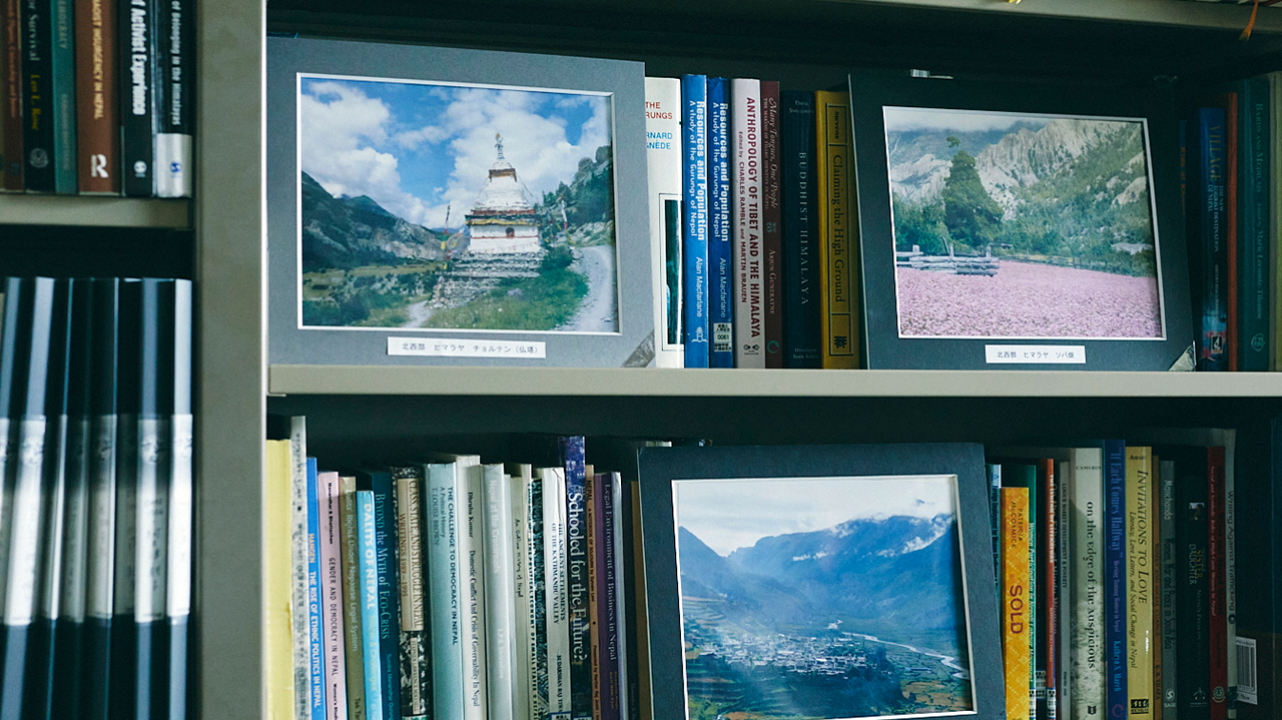Exploring rapid changes in Nepal through phenomena due to tourism and mobilities
The spread of COVID-19 has restricted our mobilities around the world for several years now, and suddenly enforced restrictions have highlighted the diverse impacts of human mobilities on socioeconomics. Professor Morimoto challenges an area study that transcends national borders in this global era, focusing on Nepal as a testbed for multifaceted studies of the various changes that mobilities and the tourism that promotes it can bring about in local communities and their people.


Izumi Morimoto
Professor, Department of International Studies, Faculty of International Studies
Graduated from the Department of Geography, Faculty of Letters and Education, Ochanomizu University. Earned her Dr. of Human Geography from the Graduate School of Humanities and Sciences at Ochanomizu University. She specializes in human geography, Nepalese area studies, and tourism studies. Prior to her current position as Professor at Meiji Gakuin University, which she has held since April 2013, she was a Lecturer and then an Associate Professor Faculty of International Studies. Her recent publications include Introducing Contemporary Tourism Geographies (editor, 2021, Nakanishiya).
Understanding Nepal from tourism and mobilities phenomena
Since the advent of the COVID-19 pandemic, we have been requested to refrain from going out and making unnecessary trips, with tourism being treated as representative of such mobilities. Indeed, tourism is a phenomenon arising from the movement of people from one place to another, despite their not having any particular business at their destination. Even so, tourism has had transformative effects on local economies, scenery, and cultures, as well as people’s consciousness, way of thinking, and their very lives. In the process, it has created spaces for tourism and encouraged people to move around the world. My research centers on such tourism and migration phenomena, focusing on Nepal as a testbed for understanding an area and its people from multiple perspectives.
Diverse changes due to encounters between the Gandharba and tourists
Among the Nepalese people who have been cooperating with my research are those of a caste called the Gandharba, who used to make a living by traveling from village to village, singing songs and playing handmade musical instruments called sarangi. The Gandharba were once considered one of “untouchable castes” and persecuted as such. Among the Gandharba are people whose lives changed forever when they went to Kathmandu, the capital city of Nepal, where they encountered foreign tourists.
There, instead of singing, they were able to craft decorated sarangis and sell them as souvenirs to foreign tourists who did not understand Nepali. Sarangis were thus once a tool by which they could make a living, but now they have become a value-added product they can sell. In their native Nepal, having a sarangi was once a sign of belonging to an untouchable caste and thus repugnant to members of other castes, but now that they have become salable goods, there are people who treat them as commodities.
In Nepal, which has experienced political instability since the end of the twentieth century, the sarangi is increasingly represented as one of cultural symbols that bring the country together. Alongside these changes, some non- Gandharba people began to play the sarangi. Their instrument becoming integrated into Nepali culture invoked a change in the Gandharba’s consciousness, and they began to assert their rights against their former oppressors. Thus, changes have occurred not only in Gandharba’s life, but also in their social and cultural structures.
So even focusing solely on the Gandharba, we can see tourism instigating change in various aspects of a country’s culture, society, economy, and politics. The interesting aspect of this research is that it reveals these wide-ranging changes surrounding the phenomenon of tourism.

Nepalese migrating to other countries
The Nepalese have a long history of crossing borders in search of better options, but that trend accelerated dramatically in the twenty-first century. Some of the Gandharbas.I have been following for some thirty years now live in places like Ireland or Australia, and some are working in the Middle East.
There has also been a recent increase in the number of Nepalese living in Japan, and they are now the sixth-largest foreign population here by nationality. Nepalese living in Japan are mostly working as cooks on a “skilled labour” visa or have come as students, and a higher percentage of Nepalese here are women than is seen in other foreign populations. The COVID-19 pandemic has brought attention to the impoverishment of some foreign communities in Japan, of which the Nepalese living here is one example. In the future, I hope to conduct further research on what kind of society is comfortable for people migrating across national borders and the extent to which Japanese society accepts or fails to accept such people.
This movement of people across borders is also changing the very nature of area studies itself. Formerly, area studies generally involved visiting a country or region of interest to deepen one’s understanding of that place. With the advance of globalization, however, it has become increasingly difficult to capture an accurate image of a place by examining it only from within its territory as represented on a map. For example, many Nepalese people are reliant on money received from relatives working abroad, so it is impossible to describe the country’s domestic society and people sans discussion of money flows from outside the country. Since 2020, therefore, I have been conducting joint research on the theme “Reconstructing the geographies by movement of people: Nepal area studies beyond national borders of Nepal.” Due to the impact of the COVID-19 pandemic, for the past few years we have limited our research to Nepalese living in Japan, but we plan to extend our scope to Nepalese communities worldwide in the future and, as our stated theme suggests, Nepalese area studies that go beyond Nepal.

During their school years, students should learn to critically look at and think about things
I teach Introducing Human Geographies as the Meiji Gakuin University Core Curriculum, Regional Geography and South Asian Area Studies as specialized subjects, and seminars in the Department of International Studies. I hope students in my courses will develop a basic understanding of human geography and an ability to perceive social issues from both local and global perspectives, as well as the ability to read books and materials, think for themselves, understand, and make judgments. Furthermore, assuming such abilities, I hope to convey the importance of always having a critical attitude, asking why things are the way they are and thinking from multiple perspectives.
The activity of studying a region is one of recognizing not only others, but also oneself. For example, there is a Nepalese dish of chopped raw water buffalo meat with spices, and when I tell students about how it starts with the slaughtering of the water buffalo with a sword, they describe it as being “barbaric” or “scary.” But what about ikezukuri dishes in Japan, where still-living fish are sliced up as sashimi? Some people may consider that as equally barbaric or scary. A society where diverse people live together will require attitudes that allow people to question their own common sense and be critical of their own ideas. I hope that by learning about human geographies and area studies, each student will acquire a multifaceted, multidimensional way of seeing and thinking about things and the ability to relativize the self.

Understanding our rapidly changing world
In today’s world of global mobilities, it is becoming increasingly difficult to simply use nationality or place of birth to establish a person’s roots. At a recent research seminar, I met a Nepalese professor who left Nepal to study in UK, then became a lecturer at a university in UK and came to Japan for a short stay. There were also Japanese faculty teaching at a university in the United States and Nepalese faculty who had come to universities in Japan after studying in the United States, so I was able to experience firsthand the complex aspects of modern mobility phenomena.
Without understanding such complex situations, we cannot aim for the multicultural society that is now being so widely promoted. It is no longer uncommon for people to live in a land that differs from their nationality or place of origin. Even within Japan, there are increasingly many children who were born and raised in Japan but whose nationality is not Japanese. As members of the same society, I believe we must pay attention to the situations in which these children encounter barriers and discrimination as they grow up.
